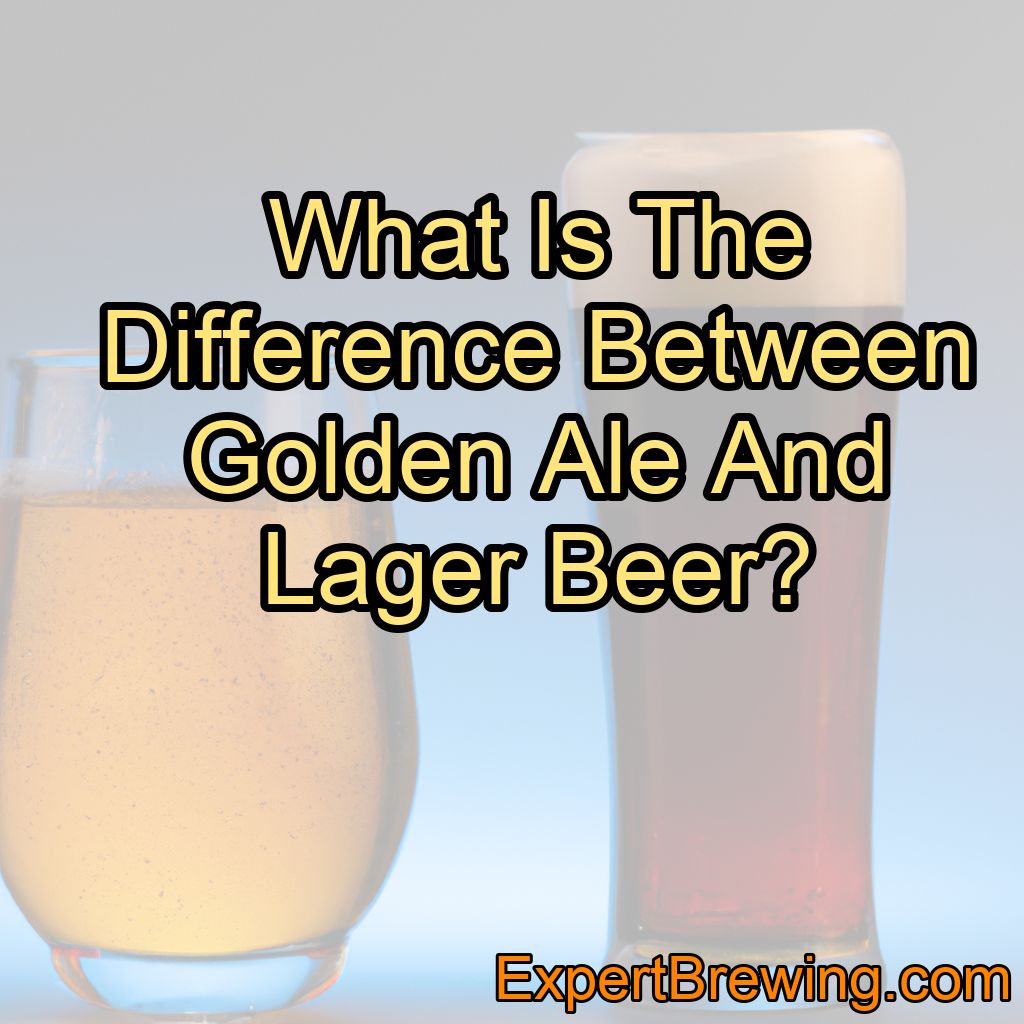Beer is one of the most popular and widely consumed alcoholic beverages in the world. From social gatherings to a quiet night at home, beer is a drink enjoyed by millions of people.
Among the vast variety of beer styles, golden ale and lager beer are two prominent and well-loved options.
The main difference between golden ale and lager beer lies in the type of yeast used during fermentation and the subsequent brewing process.
Golden ales are top-fermented using ale yeast, while lagers are bottom-fermented using lager yeast. This results in differences in aroma, flavor, appearance, and mouthfeel.
These two styles have distinct characteristics that set them apart from each other, and understanding the differences between golden ale and lager beer can help you better appreciate and enjoy your next pint.
1. Yeast and Fermentation
Golden ales and lager beers differ primarily in the type of yeast used for fermentation.
Their yeast strains differ in their fermentation characteristics and the flavors and aromas they produce in beer.
Lager yeast is a bottom-fermenting yeast that works best at lower temperatures (between 45-55°F/ 7-13°C). It ferments slowly and produces a clean, crisp, and refreshing taste with a smooth finish.
Lagers are typically fermented for several weeks at low temperatures, which helps to reduce the production of fruity and estery flavors. Some common examples of lager beers are Pilsner, Oktoberfest, and Bock.
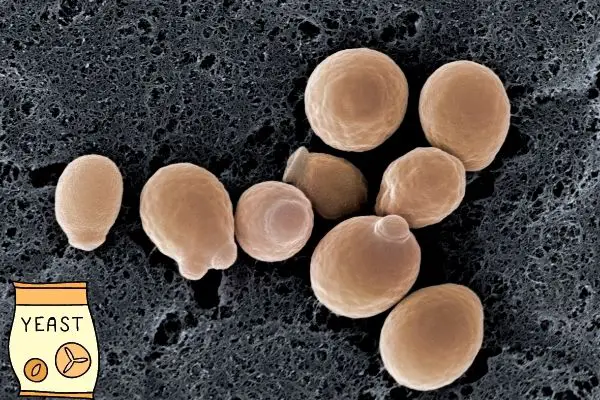
On the other hand, ale yeast is a top-fermenting yeast that works best at higher temperatures (between 60-72°F/ 15-22°C). It ferments faster and produces fruity, estery, and sometimes spicy flavors and aromas.
Ales are typically fermented for shorter periods of time and at warmer temperatures than lagers. Some common examples of ale beers are IPA, Pale Ale, and Stout.
Golden Ale Yeast
- Ale yeast (Saccharomyces cerevisiae) is a top-fermenting yeast, which means it rises to the surface during fermentation.
- Fermentation occurs at warmer temperatures, typically between 60-75°F (15-24°C).
- Ale yeast produces esters, which contribute fruity flavors and aromas to the beer.
Lager Yeast
- Lager yeast (Saccharomyces pastorianus) is a bottom-fermenting yeast, meaning it settles at the bottom of the fermenter during fermentation.
- Fermentation occurs at colder temperatures, usually between 45-55°F (7-13°C).
- Lager yeast produces fewer esters and results in a cleaner, crisper flavor profile.
2. Brewing Process
The brewing process for golden ales and lager beers is also distinct, which contributes to their differences in taste, aroma, and appearance.
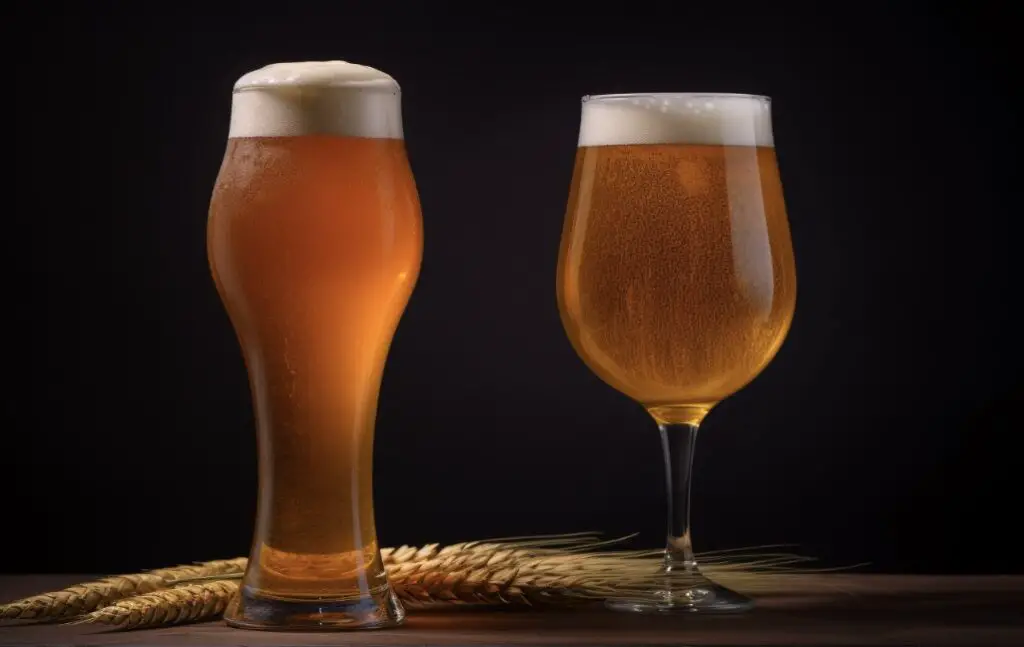
Overall, the main differences between brewing golden ales and lagers are the type of yeast used and the temperature at which they are fermented.
Golden ales use ale yeast and are fermented at warmer temperatures, while lagers use lager yeast and are fermented at cooler temperatures.
This difference in brewing temperature usually gives more esters and fruit notes in the golden ale whereas the lagers become crispier and clear.
Golden Ale Brewing Process
- Golden ales are typically brewed with pale malt as the base, along with specialty grains for added color and flavor.
- The brewing process for golden ales involves a shorter boiling time, usually around 60 minutes.
- Hops are added at various stages of the boil for bitterness, flavor, and aroma.
- The fermentation period for golden ales is generally shorter, lasting about 2-3 weeks.
Lager Beer Brewing Process
- Lager beers are brewed using a combination of pale and specialty malts.
- The brewing process for lagers involves a longer boiling time, often around 90 minutes.
- Hops are added primarily for bitterness, with less emphasis on flavor and aroma.
- The fermentation period for lagers is longer, often lasting several weeks to months.
3. Aroma and Flavor
Golden ales and lager beers have distinct aroma and flavor profiles due to the differences in yeast, fermentation, and brewing process.
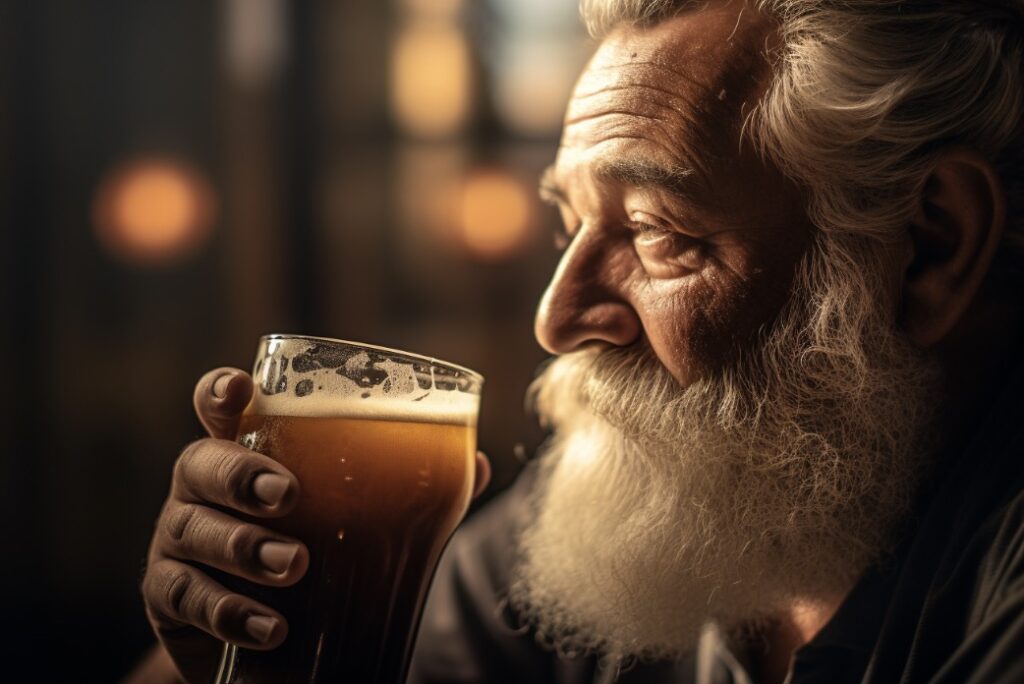
Golden Ale is a type of ale with a medium body and moderate bitterness. It has a malty and slightly sweet aroma with hints of fruit and spice, and a flavor that is crisp and refreshing with a balance of malt and hops.
Some Golden Ales may also have notes of citrus, floral, or herbal flavors like those of an IPA.
Lager, on the other hand, is a type of beer that is fermented at lower temperatures and for a longer period of time than ales, which makes lagers somewhat more mellow.
It is usually pale yellow to light amber in color, with a light body and a clean, crisp taste. The aroma of lager beer is often described as having a subtle, grainy sweetness with a hint of hops.
The flavor is also clean and crisp, with a slightly bitter finish that is characteristic of the hops used in brewing.
In summary, Golden Ale has a slightly sweet and malty aroma with hints of fruit and spice, while lager beer has a subtle, grainy sweetness with a hint of hops. Both styles have a clean, refreshing taste, but lager beer has a slightly bitter finish due to the hops used in brewing.
Golden Ale Aroma and Flavor
- Golden ales tend to have fruity, floral, and spicy aromas from the esters produced by the ale yeast.
- Flavors in golden ales can include notes of citrus, tropical fruit, and stone fruit, as well as a mild malt sweetness.
- Hops can contribute additional flavors and aromas, including earthy, herbal, and piney notes.
Lager Beer Aroma and Flavor
- The aroma of lager beers is often described as clean and crisp, with subtle malt and hop aromas.
- Lager beers have a more straightforward flavor profile, typically characterized by a clean malt backbone with low to moderate hop bitterness.
- Flavors in lager beers can include notes of bread, biscuit, and toasted malt, with subtle hints of floral or herbal hops.
4. Appearance
The appearance of golden ales and lager beers can vary, with differences in color and clarity.
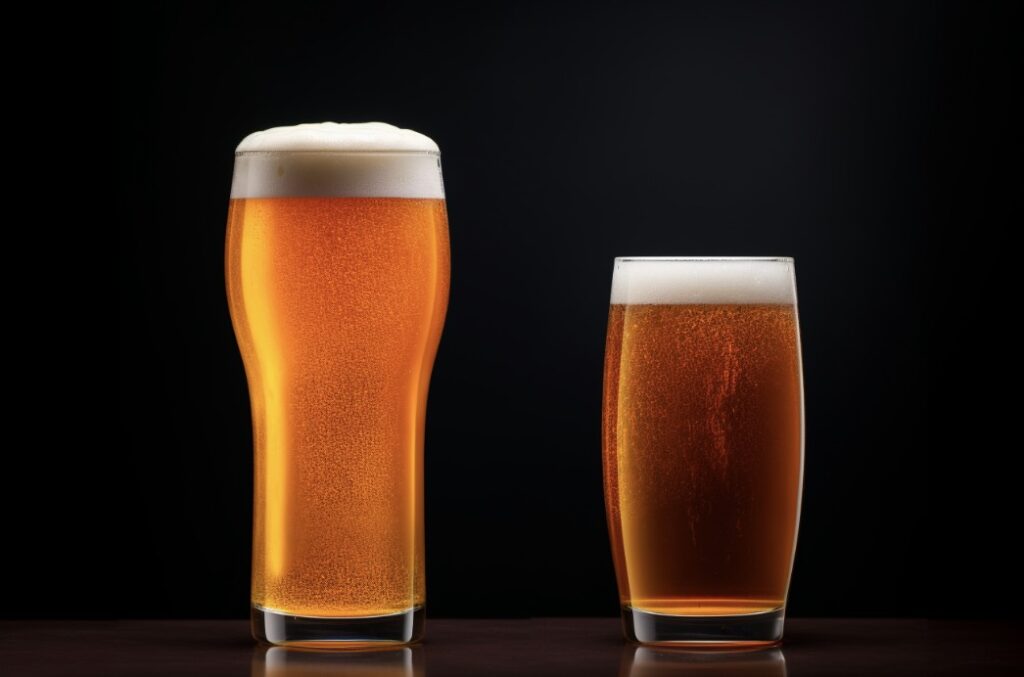
Golden Ale Appearance
- Golden ales typically have a golden to amber hue, ranging from pale to moderately dark.
- The clarity of golden ales can vary, with some being hazy or cloudy and others being crystal clear.
- A well-poured golden ale will have a dense, creamy head of foam that lingers and leaves lacing on the glass.
Lager Beer Appearance
- Lager beers range in color from pale straw to deep amber, depending on the specific style and malt used.
- Clarity is a hallmark of lager beers, with most styles being brilliantly clear and free of haze.
- A well-poured lager will have a thick, white head of foam that dissipates more quickly than that of a golden ale.
5. Mouthfeel
The mouthfeel of golden ales and lager beers is another aspect that sets them apart.
Golden Ale Mouthfeel
- Golden ales tend to have a medium body, with a smooth and slightly creamy mouthfeel.
- The carbonation level in golden ales is moderate, providing a balanced and refreshing finish.
Lager Beer Mouthfeel
- Lager beers typically have a lighter body, with a crisp and clean mouthfeel.
- The carbonation level in lagers is often higher, contributing to the crispness and refreshing quality of the beer.
6. Alcohol Content
The alcohol content of golden ales and lager beers can vary, but there are some general trends.
Golden Ale Alcohol Content
- Golden ales typically have a moderate alcohol content, ranging from 4-6% ABV (alcohol by volume).
- Some stronger golden ales can reach up to 8% ABV or higher.
Lager Beer Alcohol Content
- Lager beers generally have a lower alcohol content, with many styles falling between 4-5% ABV.
- Some stronger lager styles, such as bocks and doppelbocks, can have an ABV of 7% or higher.
7. Food Pairings
Both golden ales and lager beers can be enjoyed with a variety of food pairings.
Golden Ale Food Pairings
- Golden ales pair well with lighter fare, such as salads, grilled chicken, and seafood.
- The fruity and floral flavors of golden ales can also complement spicier dishes, like Thai or Mexican cuisine.
Lager Beer Food Pairings
- Lager beers are versatile and can be paired with a wide range of foods, from burgers and pizza to sushi and curry.
- The crisp and clean flavors of lager beers make them a perfect match for fried foods, as they help cleanse the palate between bites.
8. Popular Examples
There are countless examples of golden ales and lager beers available in the marketplace, with many breweries producing their own unique interpretations of these styles.
Popular Golden Ales
While there are many golden ales to choose from, some of the most popular include:
- Sierra Nevada Pale Ale (USA): Sierra Nevada Pale Ale is a classic American beer that has been around since 1980. It is a hoppy, golden ale that is brewed with Cascade hops, which give it a distinct citrusy flavor. This beer has a nice balance of hops and malt, making it a great option for those who like a bit of bitterness but also want some sweetness.
- New Belgium Fat Tire (USA): New Belgium Fat Tire is another popular American golden ale that has been around since 1991. It is a well-balanced beer that has a nice blend of hops and malt. This beer is named after the founder’s mountain bike, which he rode through Europe, and it has a toasty, caramel flavor that is both smooth and refreshing.
- Fuller’s Golden Pride (UK): Fuller’s Golden Pride is a strong, full-bodied golden ale that is brewed in London, England. It is made with Maris Otter malt and Goldings hops, which give it a rich, complex flavor. This beer has a sweet, malty taste with hints of fruit and a slightly bitter finish. It is a great option for those who enjoy a beer with a bit of a kick.
Popular Lager Beers
Lager is the most widely consumed beer style in the world, and there are many popular lagers to choose from. Here are three popular lagers from different parts of the world:
- Pilsner Urquell (Czech Republic): Pilsner Urquell is a classic Czech beer that has been brewed since 1842. It is a golden lager with a light, crisp taste and a slightly bitter finish. It is made with Saaz hops and Moravian malt, which give it a distinctive flavor and aroma. Pilsner Urquell is considered to be the original pilsner beer and has inspired many other lagers around the world.
- Yuengling Traditional Lager (USA): Yuengling Traditional Lager is a popular American beer that has been brewed since 1829. It is a medium-bodied lager with a caramel malt flavor and a slightly hoppy finish. It is made with a combination of American and European hops and has a smooth, refreshing taste that is perfect for any occasion.
- Samuel Adams Boston Lager (USA): Samuel Adams Boston Lager is a flagship beer from the Boston Beer Company, which was founded in 1984. It is an amber-colored lager with a rich, complex flavor that is made with a blend of two-row malt and Noble hops. It has a slightly sweet taste with a crisp, clean finish and is a great option for those who enjoy a full-bodied lager with a bit of a bite.
9. Final Thoughts
Both golden ales and lager beers have their own unique characteristics and appeal, making them enjoyable options for a wide range of beer drinkers. Whether you prefer the fruity and floral flavors of golden ales or the crisp and clean taste of lager beers, exploring the world of beer can be a rewarding and delicious experience.
In conclusion, the difference between golden ale and lager beer can be summarized in the following facts:
1. Golden ales are top-fermented using ale yeast, while lagers are bottom-fermented using lager yeast.
2. Fermentation temperatures differ, with golden ales fermenting at warmer temperatures and lagers at colder temperatures.
3. The brewing process for each style is distinct, with differences in boiling time, hop additions, and fermentation duration.
4. Aroma and flavor profiles vary, with golden ales having fruity and floral notes and lagers being characterized by clean malt and subtle hop flavors.
5. Golden ales typically have a denser, creamier head, while lagers have a lighter, more quickly dissipating foam.
6. Mouthfeel differs, with golden ales having a smoother and slightly creamier texture, and lagers being crisper and cleaner.
7. Alcohol content can vary, with golden ales generally having a higher ABV than lagers.
8. Food pairings can be versatile for both styles, with golden ales complementing lighter fare and spicier dishes, and lagers being a good match for fried foods and a wide range of cuisines.
9. There are many popular examples of both golden ales and lager beers, showcasing the diversity and creativity of the brewing industry.
10. Both golden ales and lager beers offer unique and enjoyable drinking experiences, making them popular choices for beer lovers around the world.
FAQs
Is an ale stronger than a lager?
Not necessarily. The strength of a beer depends on its alcohol by volume (ABV), which can vary widely among both ales and lagers.
Which beer is strong ale or lager?
Strong ale is typically stronger in alcohol content than lager, which is a lighter beer. However, there are exceptions and variations within each category.
What is the major difference between ale and lager?
The major difference between ale and lager is the type of yeast used in the fermentation process. Ales are made with a type of yeast that ferments at warmer temperatures and produces more fruity and complex flavors, while lagers are made with a yeast that ferments at cooler temperatures and produces a crisper, cleaner taste.
Which beer is better lager or ale?
I like both at different occasions. But I cannot answer on your behalf as the answer is subjective and depends on individual taste preferences. Lagers are typically lighter and crisper, while ales are often more robust and flavorful. It is best to try both and decide which you prefer.
What kind of beer is a golden ale?
A golden ale is a type of beer that is light in color and has a moderate hop flavor. It is brewed using pale malt and often has a fruity or floral aroma.
What is more popular ale or lager?
It depends on the region and the preferences of the local population. In some areas, ale is more popular, while in others, lager is more commonly consumed. Overall, lager tends to be more popular worldwide.

